
The geography of Antarctica is dominated by its south polar location and, thus, by ice. The Antarctic continent, located in the Earth's southern hemisphere, is centered asymmetrically around the South Pole and largely south of the Antarctic Circle. It is washed by the Southern Ocean or, depending on definition, the southern Pacific, Atlantic, and Indian Oceans. It has an area of more than 14.2 million km2. Antarctica is the largest ice desert in the world.

In geography, a pole of inaccessibility is the farthest location in a given landmass, sea, or other topographical feature, starting from a given boundary, relative to a given criterion. A geographical criterion of inaccessibility marks a location that is the most challenging to reach according to that criterion. Often it refers to the most distant point from the coastline, implying the farthest point into a landmass from the shore, or the farthest point into a body of water from the shore. In these cases, a pole of inaccessibility is the center of a maximally large circle that can be drawn within an area of interest only touching but not crossing a coastline. Where a coast is imprecisely defined, the pole will be similarly imprecise.
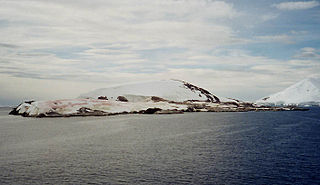
Petermann Island is an island 1 nautical mile long, lying 1 nautical mile southwest of Hovgaard Island in the Wilhelm Archipelago, Antarctica.

Booth Island is a Y-shaped island, 5 nautical miles long and rising to 980 metres (3,220 ft) in the northeast part of the Wilhelm Archipelago, Antarctica.
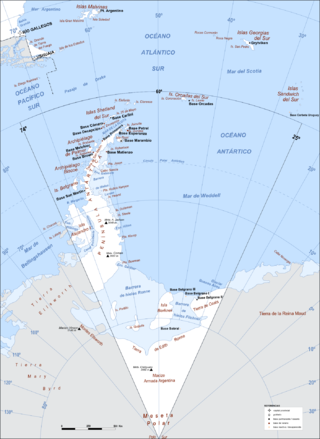
Argentine Antarctica is an area on Antarctica claimed by Argentina as part of its national territory. It consists of the Antarctic Peninsula and a triangular section extending to the South Pole, delimited by the 25° West and 74° West meridians and the 60° South parallel. This region overlaps with British and Chilean claims in Antarctica. None of these claims have widespread international recognition.

Anvers Island or Antwerp Island or Antwerpen Island or Isla Amberes is a high, mountainous island 61 km long, the largest in the Palmer Archipelago of Antarctica. It was discovered by John Biscoe in 1832 and named in 1898 by the Belgian Antarctic Expedition under Adrien de Gerlache after the province of Antwerp in Belgium. It lies south-west of Brabant Island at the south-western end of the group. The south-western coastline of the island forms part of the Southwest Anvers Island and Palmer Basin Antarctic Specially Managed Area. Cormorant Island, an Important Bird Area, lies 1 km off the south coast.

Galindez Island is an island 0.5 nautical miles long, lying immediately east of Winter Island in the Argentine Islands, Wilhelm Archipelago, Antarctica. It is home to the Vernadsky Research Base.
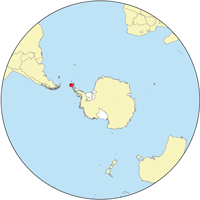
Holy Trinity Church is a small Russian Orthodox church on King George Island near Bellingshausen Station, a Russian research station in Antarctica. It is one of the eight churches on Antarctica. It is the southernmost Eastern Orthodox church in the world.

Seymour Island or Marambio Island, is an island in the chain of 16 major islands around the tip of the Graham Land on the Antarctic Peninsula. Graham Land is the closest part of Antarctica to South America. It lies within the section of the island chain that resides off the west side of the peninsula's northernmost tip. Within that section, it is separated from Snow Hill Island by Picnic Passage, and sits just east of the larger key, James Ross Island, and its smaller, neighboring island, Vega Island.

Hovgaard Island is an island 3 nautical miles long, lying 1.5 nautical miles southwest of Booth Island in the Wilhelm Archipelago, Antarctica.
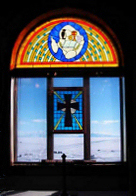
Religion in Antarctica is largely dominated by Christianity, with churches being the only religious buildings on the continent. Although used regularly for Christian worship, the Chapel of the Snows has also been used for Buddhist and Baháʼí Faith ceremonies. Some of the early religious buildings are now protected as important historical monuments.

Cornwall Island is a low ice-free island off the north coast of Robert Island in the South Shetland Islands, Antarctica. Surface area 15 hectares. Mónica Rock is lying 1.65 km (1.03 mi) west of the island and 3.4 km (2.1 mi) north of Passage Rock, 2.84 km (1.76 mi) east of Table Island and 2 km (1.2 mi) south of Potmess Rocks. The area was visited by early 19th century sealers operating from nearby Clothier Harbour.

The Ambrose Rocks are a small cluster of rocks situated southwest of the southern Argentine Islands and 1 nautical mile (2 km) northwest of the Gaunt Rocks, off the west coast of Graham Land, Antarctica. They were named by the UK Antarctic Place-Names Committee for David A. Ambrose, a survey assistant of the Hydrographic Survey Unit from HMS Endurance working in this area in February 1969.

The Chapel of Santísima Virgen de Luján or the Chapel of the Blessed Virgin of Luján is a Roman Catholic chapel located at the Argentine base Marambio on Seymour-Marambio Island in Antarctica. It is the third most southern place of worship of any religion. It is one of eight churches on Antarctica. The permanent steel-structured chapel is used for Christian worship by the various Argentine personnel on station. The chapel features a bell tower and cross.
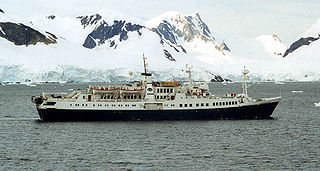
Paradise Harbour is a wide embayment behind Lemaire Island and Bryde Island, indenting the west coast of Graham Land, Antarctica, between Duthiers Point and Leniz Point. The name was first applied by whalers operating in the vicinity and was in use by 1920.
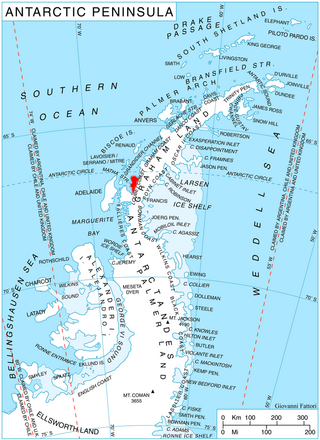
McCance Glacier is the 30-km long and 5 km wide glacier draining the Hutchison Hill area on the west slopes of Avery Plateau on Loubet Coast in Graham Land, Antarctica. It flows north-northwestwards along the west side of Osikovo Ridge, Kladnitsa Peak and Rubner Peak and enters Darbel Bay.
The Vedel Islands are a group of small islands lying 2 nautical miles west of Hovgaard Island in the Wilhelm Archipelago, Antarctica.
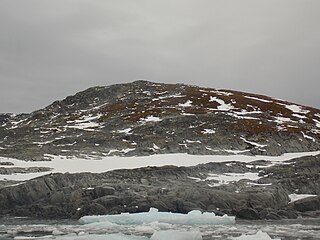
Green Island is one of the Berthelot Islands group, lying off the west coast of Graham Land, Antarctica.
Shut Island is the partly ice-free island extending 573 m in west–east direction and 520 m in south–north direction in the Dannebrog Islands group of Wilhelm Archipelago in the Antarctic Peninsula region. Its surface area is 14 ha.


















